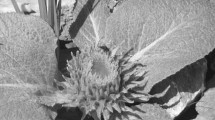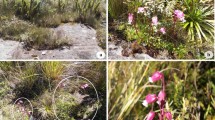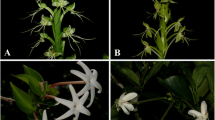Abstract
Reduction of pollen flow can affect plant abundance and population viability and cause selection on plant mating system and floral traits. Little is known on the effect of this phenomenon in species naturally restricted to small and isolated habitats, that may have developed strategies to cope with long-term isolation and small population size. We investigated the pollination ecology of the endemic distylous winter-flowering P. allionii to verify the possible limitation of female fitness due to reduced pollinator visits. We recorded a higher production of pollen grains in long-styled morph, and a higher seed set in short-styled morph. The high intra-morph variability of sexual organ position may explain the hybridization phenomena allowing and easier intra-morph pollination. The fruit set is constant, although its winter-flowering period might decrease pollen transfer. Nevertheless, the lower competition for pollinators with neighbouring plants and the long-lasting anthesis may offset its reproductive success. Even if our results show no evidence of imminent threats, changes in plant–pollinator interactions might increase inbreeding, resulting in an increased extinction risk.



Similar content being viewed by others
References
Ågren J (1996) Population size, pollinator limitation, and seed set in the self-incompatible herb Lythrum salicaria. Ecology 77:1779–1790
Aronne G, Buonanno M, De Micco V, Giovanetti M, Arena C (2011) Effect of environmental factors on morpho-functional traits of Primula palinuri Petagna (Primulaceae). Bollettino dei Musei ed Istituti Biologici dell’Università di Genova 73:174
Barbi S (2008) Studi di biologia riproduttiva per la conservazione di alcune specie vegetali dell’ambiente mediterraneo e per la valorizzazione di produzioni eco-compatibili. PhD Thesis. University of Naples. XXI cycle
Barbi S, Aronne G, De Micco V (2007) Successo riproduttivo, germinazione dei semi e strategie di attecchimento delle plantule di Primula palinuri Petagna (Primulaceae) 102° Congresso S.B.I. (Palermo, 26–29 settembre 2007), p 255
Barrett SCH (2002) The evolution of plant sexual diversity. Nature 3:274–284
Barrett SCH, Jesson LK, Baker AM (2000) The evolution and function of stylar polymorphisms in flowering plants. Ann Bot Lond 85 (Suppl A):253–265
Becker T, Voss N, Durka W (2011) Pollen limitation and inbreeding depression in an ‘old rare’ bumblebee-pollinated grassland herb. Plant Biol 13:857–864
Bernhardt CE, Mitchell RJ, Michaelsy HJ (2008) Effects of population size and density on pollinator visitation, pollinator behavior, and pollen tube abundance in Lupinus perennis. Int J Plant Sci 169:944–953
Boyd M, Silvertown J, Trucker C (1990) Population ecology of heterostyle and homostyle Primula vulgaris, growth, survival and reproduction in field populations. J Ecol 78:799–813
Brys R, Jacquemyn H, Endels P, Hermy M, De Blust G (2003) The relationship between reproductive success and demographic structure in remnant populations of Primula veris. Acta Oecol 24:247–253
Brys R, Jacquemyn H, De Bruyn L, Hermy M (2007) Pollination success and reproductive output in experimental populations of the self-incompatible Primula vulgaris. Int J Plant Sci 168:571–578
Brys R, Jacquemyn H, Beeckman T (2008) Morph-ratio variation, population size and female reproductive success in distylous Pulmonaria officinalis (Boraginaceae). J Evol Biol 21:1281–1289
Burnat E. (1897) Notes sur les jardins botaniques alpins. Bulletins des travaux de la Société Murithienne du Valais 26(append):1–16
Byers DL (1995) Pollen quantity and quality as explanations for low seed set in small populations exemplified by Eupatorium (Asteraceae). Am J Bot 82:1000–1006
Casazza G, Granato L, Minuto L, Conti E (2012) Polyploid evolution and Pleistocene glacial cycles: a case study from the alpine primrose Primula marginata (Primulaceae). BMC Evol Biol 12:56
Casazza G, Marsili S, Granato L, Conti E, Noble V, Selvaggi A, Minuto L (2013) Distribution range and ecological niche of Primula marginata Curtis (Primulaceae). Pl Biosyst. doi:10.1080/11263504.2012.760495
Chen M (2009) Comparative reproductive biology of Primula merrilliana Schltr. and P. cicutariifolia Pax. Plant Syst Evol 278:23–32
Conti F, Manzi A, Pedrotti F (1992) Libro Rosso delle Piante d’Italia. WWF, Roma
Conti F, Manzi A, Pedrotti F (1997) Liste Rosse Regionali delle Piante d’Italia. WWF, Camerino
Cook BI, Wolkovich EM, Parmesan C (2012) Divergent responses to spring and winter warming drive community level flowering trends. Proc Natl Acad Sci USA 109:9000–9005
Cozzolino S, Widmer A (2005) Orchid diversity, an evolutionary consequence of deception? Trends Ecol Evol 20:487–494
Darwin C (1877) The different forms of flowers on plants of the same species. John Murray, London
de Vos JM, Keller B, Isham ST, Kelso S, Conti E (2012) Reproductive implications of herkogamy in homostylous primroses: variation during anthesis and reproductive assurance in alpine environments. Funct Ecol 26:854–865
Dodd ME, Silvertown J, Chase MW (1999) Phylogenetic analysis of trait evolution and species diversity variation among angiosperm families. Evolution 53:732–744
Eckert CG, Barrett SCH (1994) Post-pollination mechanism and the maintenance of outcrossing in self-compatible, tristylous, Decodon verticillatus (Lythraceae). Heredity 72:396–411
Eckert CG, Kalisz S, Geber MA, Sargent R, Elle E, Cheptou P-O, Goodwillie C, Johnston MO, Kelly JK, Moeller DA, Porcher E, Ree RH, Vallejo-Marin M, Winn AA (2010) Plant mating systems in a changing world. Trends Ecol Evol 25:35–43
Eriksson O, Bremer B (1991) Fruit characteristics, life forms, and species richness in the plant family Rubiaceae. Am Nat 138:751–761
Fey L (1929) Untersuchungen zur Phananalyse der Artbastardes Primula variabilis Goupil (P. veris L. em. Hudson × P. vulgaris Hudson), der Eltemarten und von Primula elatior (L.) Schreber. Institut fur Allgemeine Botanik der Universitat Zurich II. Serie No.10
Fisogni A, Cristofolini G, Podda L, Galloni M (2011) Reproductive ecology in the endemic Primula apennina Widmer (Primulaceae). Plant Biosyst 145:353–361
García-Robledo C, Mora F (2007) Pollination biology and the impact of floral display, pollen donors, and distyly on seed production in Arcytophyllum lavarum (Rubiaceae). Plant Biol 9:453–461
Gilman RT, Fabina NS, Abbott KC, Rafferty NE (2012) Evolution of plant–pollinator mutualisms in response to climate change. Evol Appl 5:2–16
Giménez-Benavides L, Garcia-Camacho R, Maria Iriondo J, Escudero A (2011) Selection on flowering time in Mediterranean high-mountain plants under global warming. Evol Ecol 25:777–794
Gordo O, Sanz JJ (2010) Impact of climate change on plant phenology in Mediterranean ecosystems. Global Change Biol 16:1082–1106
Harder LD, Aizen MA (2010) Floral adaptation and diversification under pollen limitation. Phil Trans R Soc B 365:529–543
Internicola AI, Bernasconi G, Gigord LDB (2008) Should food-deceptive species flower before or after rewarding species? An experimental test of pollinator visitation behaviour under contrasting phenologies. J Evol Biol 21:1358–1365
Jennersten O (1988) Pollination in Dianthus deltoides (Caryophyllaceae), effects of habitat fragmentation on visitation and seed set. Conserv Biol 2:359–366
Johnson SD, Steiner KE (2000) Generalisation versus specialization in plant pollination systems. Trends Ecol Evol 15:140–143
Kálmán K, Medvegy A, Pénzes ZS, Mihalik E (2007) Morph-specific variation of floral traits associated with reciprocal herkogamy in natural populations of Primula vulgaris and Primula veris. Plant Syst Evol 268:15–27
Kay QON, Daoud HS, Stirton CH (1981) Pigment distribution, light reflection and cell structure in petals. Bot J Linn Soc 83:57–84
Kearns CA, Inouye DW, Waser NM (1998) Endangered mutualisms: the conservation of plant–pollinator interactions. Annu Rev Ecol Syst 29:83–112
Keller B, de Vos JM, Conti E (2012) Decrease of sexual organ reciprocity between heterostylous primrose species, with possible functional and evolutionary implications. Ann Bot 110:1233–1244
Kéry M, Matthies D, Schmid B (2003) Demographic stochasticity in population fragments of the declining distylous perennial Primula veris (Primulaceae). Basic Appl Ecol 4:197–206
Liu Y, Mu J, Niklas KJ, Li G, Sun S (2012) Global warming reduces plant reproductive output for temperate multi-inflorescence species on the Tibetan plateau. New Phytol 195:427–436
Martini E (1994) Ricerche geobotaniche su Moehringia lebrunii Merxm. e Primula allionii Loisel. Endemismi ristretti delle Alpi Marittime. Rev Valdôtaine d’Hist Naturelle 48:229–236
Matsumura C, Washitani I (2002) Heterostylous morph differences in pollen transfer and deposition patterns in Primula sieboldii on a visitation by a queen bumblebee, measured with a semi-natural experimental system. Plant Species Biol 17:1–12
Minuto L, Guerrina M, Roccotiello E, Casazza G (2012a) Demographic structure and reproductive success of Primula allionii, a plant endemic to Maritime Alps. Bollettino dei Musei ed Istituti Biologici dell’Università di Genova 74:38–54
Minuto L, Guerrina M, Roccotiello E, Casazza G (2012b) Reproductive efficiency of Primula allionii: is this endemic really threatened? Bollettino dei Musei ed Istituti Biologici dell’Università di Genova 74:87–106
Nishihiro J, Washitani I (2011) Post-pollination process in a partially self-compatible distylous plant, Primula sieboldii (Primulaceae). Plant Species Biol 26:213–220
Nuttman C, Willmer P (2003) How does insect visitation trigger floral colour change? Ecol Entomol 28:467–474
Olivier L, Galland JP, Maurin H (1995) Livre Rouge de la flore menacée de France. Tome I: Espèces prioritaires. Collection Patrimoines Naturels (Série Patrimoine Génétique). n°20. SPN-IEGB/MNHN, DNP/Ministère Environnement, CBN Porquerolles, Paris, 486 pp
Pailler T, Thompson JD (1997) Distyly and variation in heteromorphic incompatibility in Gaertnera vaginata (Rubiaceae) endemic to La Reunion Island. Am J Bot 84:315–327
Phillips RD, Hopper SD, Dixon KW (2010) Pollination ecology and the possible impacts of environmental change in the Southwest Australian Biodiversity Hotspot. Phil Trans R Soc B 365:517–528
Piper JG, Charlesworth B (1986) The evolution of distyly in Primula vulgaris. Biol J Linn Soc 29:123–137
Proctor M, Yeo P, Lack A (1996) The natural history of pollination. Timber Press, Portland
R Development Core Team (2009) R: a language and environment for statistical computing. R Foundation for Statistical Computing, Vienna, Austria. http://www.r-project.org
Raine NE, Chittka L (2007) The adaptive significance of sensory bias in a foraging context: floral colour preferences in the bumblebee Bombus terrestris. PLoS ONE 2:e556
Richards AJ (2003) Primula. Timber Press, New York
Sage TL, Strumas F, Cole WW, Barrett SCH (1999) Differential ovule development following self- and cross-pollination, the basis of self-sterility in Narcissus triandrus (Amaryllidaceae). Am J Bot 86:855–870
Sanchez JM, Ferrero V, Navarro L (2008) A new approach to the quantification of degree of reciprocity in distylous (sensu lato) plant populations. Ann Bot Lond 102:463–472
Schou O (1983) The distyly in Primula elatior (L.) Hill (Primulaceae), with a study of flowering phenology and pollen flow. Bot J Linn Soc 86:261–274
Schultze-Motel P, Lamprecht I (1994) Correlation of sound generation and metabolic heat flux in the bumblebee Bombus lapidarius. J Exp Biol 187:315–318
Shao JW, Zhang XP, Zhang ZX, Zhu GP (2008) Identification of effective pollinators of Primula merrilliana and effects of flower density and population size on pollination efficiency. J Syst Evol 46:537–544
StatSoft Inc. (2007) Statistica (data analysis software system) version 8.0. Available from URL. http://www.statsoft.com
Stelzer RJ, Chittka L, Carlton M, Ings TC (2010) Winter active bumblebees (Bombus terrestris) achieve high foraging rates in urban Britain. PLoS ONE 5:e9559
Thompson JD, Arroyo J (2009) Variations on a Darwinian theme: evolutionary transitions to heterostyly. In: Cristofolini G, Managlia A (eds) Il giardino di Darwin. L’evoluzione delle piante. Umberto Allemandi & C, Torino, pp186–200
Van Rossum F, De Sousa SC, Triest L (2006) Morph-specific differences in reproductive success in the distylous Primula veris in a context of habitat fragmentation. Acta Oecol 30:426–433
Washitani I (1996) Predicted genetic consequences of strong fertility selection due to pollinator loss in an isolated population of Primula sieboldii. Cons Biol 10:59–64
Washitani I, Kato M, Nishihiro J, Suzuki K (1994) Importance of queen bumble bees as pollinators facilitating inter-morph crossing in Primula sieboldii. Plant Species Biol 9:169–176
Wiens D, Slaton MR (2011) The mechanism of background extinction. Biol J Linn Soc 105:255–268
Wolff D, Liede-Schumann S (2007) Evolution of flower morphology, pollen dimorphism, and nectar composition in Arcytophyllum, a distylous genus of Rubiaceae. Org Div Evol 7:106–123
Woodell SRJ (1960) What pollinates Primulas? New Sci 8:568–571
Zhang L-B, Comes HP, Kadereit JW (2004) The temporal course of Quaternary diversification in the European high mountain endemic Primula sect. Auricula (Primulaceae). Int J Plant Sci 165:191–207
Acknowledgments
We are grateful to G. Troiano (DISTAV, University of Genoa) for insect identification. Special thanks to R. Poggi (Genoa Natural Science Museum) for providing the insects used for measurements. We thank the anonymous reviewers and editor for their valuable comments.
Author information
Authors and Affiliations
Corresponding author
Rights and permissions
About this article
Cite this article
Minuto, L., Guerrina, M., Roccotiello, E. et al. Pollination ecology in the narrow endemic winter-flowering Primula allionii (Primulaceae). J Plant Res 127, 141–150 (2014). https://doi.org/10.1007/s10265-013-0588-9
Received:
Accepted:
Published:
Issue Date:
DOI: https://doi.org/10.1007/s10265-013-0588-9




